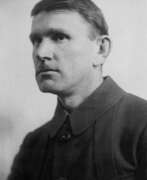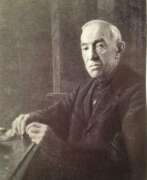Impressionism Makovets


Sergey Vasilyevich Gerasimov (Russian: Серге́й Васи́льевич Гера́симов) is a celebrated figure in the annals of Russian art, known for his adept navigation through various artistic movements, transitioning from Impressionism to the robust narratives of Socialist Realism. Born in Mozhaisk, Russia, in 1885, his multifaceted career spanned painting, teaching, and book illustration, marking him as a versatile artist and educator. Educated under prominent figures such as Konstantin Korovin, Gerasimov dedicated a significant part of his life to nurturing the next generation of artists.
His artistic oeuvre is notable for its versatility and emotional depth, capturing the Soviet ethos with a unique blend of realism and evocative landscape and genre paintings. His work during critical periods in Soviet history, including the Stalin era and World War II, offers a vivid portrayal of the times. Gerasimov's mastery is evident in celebrated pieces like "The Peasant Uprising of 1860" and "Collective Farm Holiday," which are held in high esteem and displayed in prestigious venues such as the Tretyakov Gallery.
Gerasimov's legacy extends beyond his paintings. As an influential teacher at the Surikov Art Institute, he shaped the careers of numerous Soviet artists, leaving a lasting impact on the artistic landscape. His dedication to art and education has cemented his status as a revered figure in the history of Russian and Soviet art.
For those interested in the rich heritage of Russian art, Sergey Vasilyevich Gerasimov's life and work present an invaluable perspective on the cultural and political shifts of his era. His legacy continues to inspire and influence, making his art a focal point for collectors and art aficionados alike.
To stay abreast of the latest findings and exhibitions featuring Gerasimov's compelling works, signing up for updates is highly recommended. This subscription will ensure that enthusiasts are well-informed about upcoming sales and auction events showcasing the timeless creations of Sergey Vasilyevich Gerasimov.


Nikolaу Petrovich Krymov (Russian: Никола́й Петро́вич Кры́мов), born on May 2, 1884, in Moscow, Russia, was a renowned Russian and Soviet painter and art theoretician, celebrated for his contributions to landscape painting and art education. Krymov hailed from an artistic family, and his education in the arts was comprehensive, studying under prominent figures like Abram Arkhipov, Nikolay Kasatkin, Leonid Pasternak, Valentin Serov, and Konstantin Korovin at the Moscow School of Painting, Sculpture and Architecture. His artistic journey began with participation in student exhibitions in 1906, and his works were soon featured in major exhibitions, including those of the Blue Rose, the Golden Fleece, and the Union of Russian Artists, marking his integration into significant artistic circles of his time.
Krymov's early works were significantly influenced by Isaac Levitan's delicate vision of Russian nature, focusing on the subtleties of daily transitions and the beauty of the Russian countryside. This influence is evident in Krymov's ability to convey the ethereal qualities of light and atmosphere in his landscapes, which were appreciated for their emotional depth and technical prowess. Among his notable works are paintings like "Dawn" (1908), "On the Mill" (1915), "First Snow" (1917), and "Hot Day" (1920), all of which demonstrate his masterful handling of light, shadow, and composition to capture the essence of nature.
Krymov's career also included significant contributions to art education and theory. He was an active participant in the "Blue Rose" movement, where he explored symbolism and impressionism, later transitioning towards a more classical approach in his landscapes. This evolution in style reflected his continuous search for an ideal harmony between reality and fantasy in his works. His dedication to art was recognized with several honors, including the title of Honorary Art Worker of the Russian Federation and the prestigious Order of the Red Banner of Labour.
Krymov's legacy extends beyond his paintings to include his influence on future generations of artists through his teaching and theoretical writings. His works are housed in museums and private collections, where they continue to be celebrated for their contribution to the landscape genre and Russian art.
For art collectors and experts interested in the rich tapestry of Russian landscape painting, Krymov's works offer a window into the soul of Russian nature and the artistic movements of the early 20th century. To stay updated on new product sales and auction events related to Nikolay Petrovich Krymov, signing up for updates is highly recommended. This subscription ensures that enthusiasts and collectors alike are informed about opportunities to acquire pieces by this illustrious artist, celebrating his enduring influence on the world of art.


Nikolay Andreyevich Tyrsa (Russian: Николай Андреевич Тырса) was a Russian and Soviet graphic artist and painter of the first half of the 20th century. He is known as a brilliant illustrator and one of the founders of the Leningrad school of book graphics. Tyrsa's paintings are diverse in genre: among them there are many portraits, still lifes, landscapes, nudes, illustrations of children's and classical literature. His works are distinguished by soft tone, blurred outlines, delicacy of colors, harmonious color combinations, lyricism and observation.
Nikolay Tyrsa preferred graphic art and watercolors until the 1930s, and then oil painting. He was a follower of the traditions of the "World of Art" association of artists. He was also one of the brightest representatives of the Leningrad Landscape School, whose followers painted chamber and contemplative cityscapes. The influence of the French Impressionists can be traced in the work of this group.
Tyrsa designed many children's books, and in his later years he illustrated classical literature - works by Alexander Pushkin, Mikhail Lermontov, and Leo Tolstoy. Shortly before his death, Nikolai Tyrsa worked with Vera Mukhina to design glass vases, decanters and glasses.